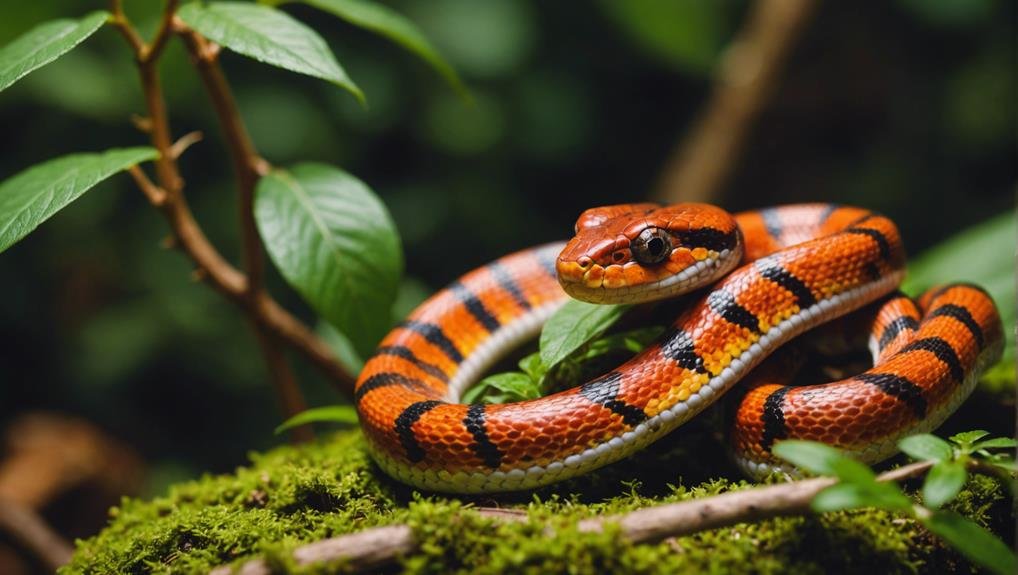When you decide to care for a corn snake, you need to focus on creating an ideal habitat. A wooden vivarium with proper ventilation and a temperature gradient from 90°F to 70°F is crucial. You’ll also need to include hiding spots and climbing branches to mimic their natural environment. Temperature control requires thermostats to maintain the appropriate basking and nighttime temperatures. Don’t forget lighting and heat sources like basking lamps and UVB lighting play a significant role in their well-being. But have you considered how humidity and substrate choices impact their health? Let’s explore that next.
Key Takeaways
- Maintain a temperature gradient of 90°F to 70°F in the wooden vivarium for optimal thermoregulation.
- For proper lighting and heat, use a basking lamp paired with a thermostat and a 5% T8 UVB tube.
- Keep humidity levels between 40-60%, increasing to 60-70% during shedding, monitored with a hygrometer.
- Provide suitable substrates like aspen shavings or paper towels, avoiding cedar or pine to prevent respiratory issues.
- Regularly monitor health, observe behavior, and schedule annual veterinary check-ups for preventive care.
Habitat Setup
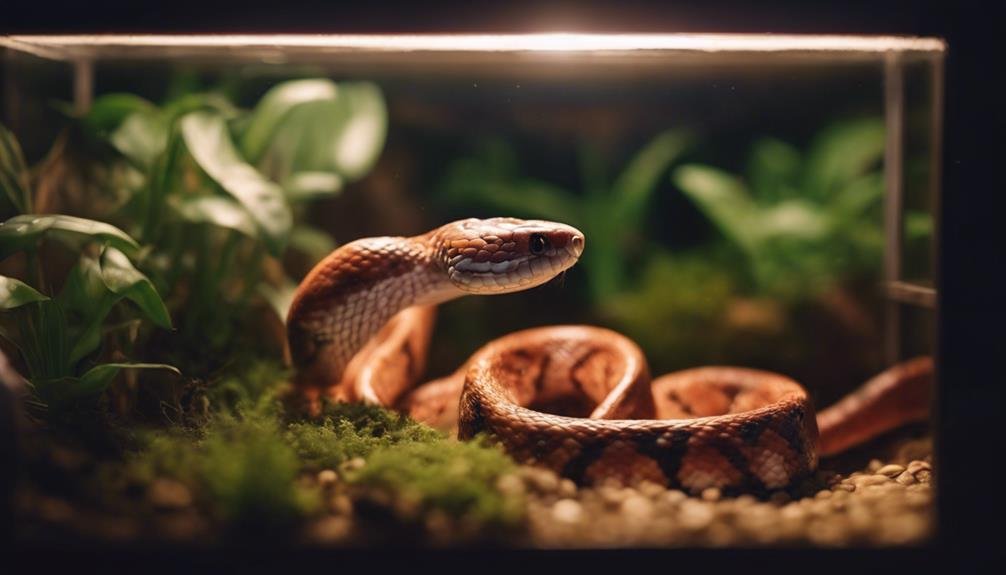

Setting up the perfect habitat for your corn snake requires careful attention to temperature, humidity, and security. Start by choosing a wooden vivarium, which helps maintain stable temperatures. It must have proper ventilation to prevent excess moisture buildup and ensure a healthy environment.
Corn snakes thrive in a habitat with a temperature gradient, so create areas ranging from 90°F to 70°F. This allows your snake to regulate its body temperature by moving to different enclosure parts.
Incorporate various hiding spots throughout the vivarium. These can be store-bought hides or simple objects like overturned flower pots. Hiding spots provide your snake with security and comfort.
Add climbing branches to the enclosure as well. Corn snakes enjoy exploring, and branches mimic their natural environment, providing physical and mental stimulation.
Maintain suitable humidity levels, typically around 40-50%. Line the bottom of the enclosure with substrates like aspen shavings or paper towels. These substrates are easy to clean and help create a secure enclosure for your snake.
Temperature Control
Proper temperature control is essential for maintaining your corn snake’s health and well-being. To guarantee appropriate digestion and metabolism, you must set a basking spot temperature of around 90°F. This high-temperature area allows your corn snake to warm up and process its food efficiently.
At night, you can let the temperatures drop to around 70°F to mimic their natural environment and promote healthy rest.
Use a thermostat to regulate heat sources and prevent dangerous temperature fluctuations. This is critical because sudden changes can stress your snake and negatively impact its immune function.
Providing a gradient of temperatures within the enclosure allows your corn snake to thermoregulate and choose its preferred temperature zones. This setup helps them maintain their body temperature within a healthy range and supports their overall well-being.
Careful temperature control ensures your corn snake can move to warmer or cooler areas as needed, aiding their digestion and overall physiological processes.
Lighting and Heat
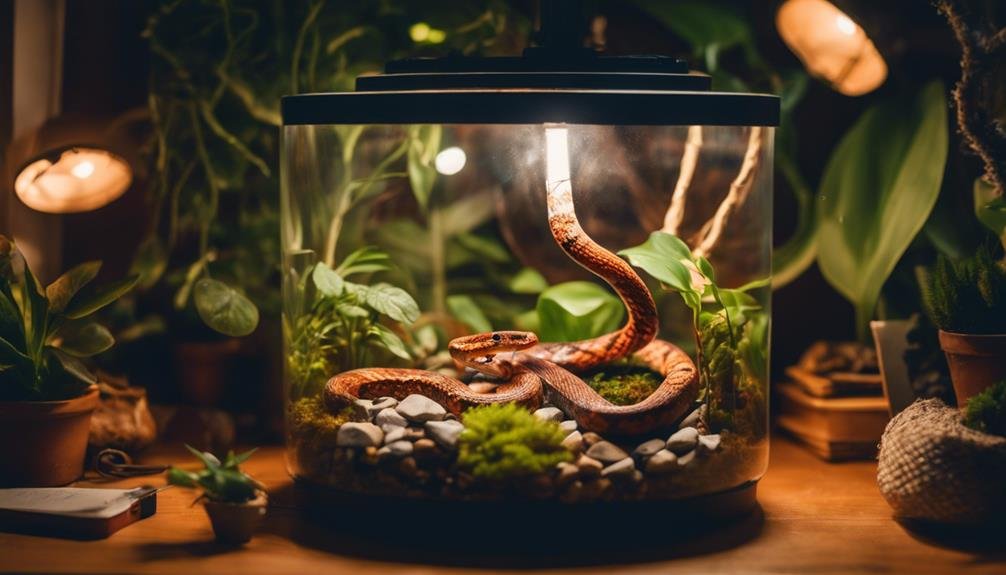

In addition to temperature control, providing appropriate lighting and heat sources is essential for your corn snake’s health and comfort. Corn snakes thrive with a well-maintained basking spot and a consistent nighttime heat source. Aim to create a basking spot around 90°F using a basking lamp. Pair this lamp with a thermostat to maintain the ideal temperature gradient within the enclosure.
A heat mat can provide the necessary warmth for nighttime without disrupting your snake’s natural day-night cycle. While UVB lighting isn’t critical, it benefits calcium absorption and overall well-being. A 5% T8 UVB tube mounted at the back of the enclosure can offer additional lighting advantages.
To make sure your corn snake is comfortable and healthy, consider the following:
- Basking lamp: Creates a warm basking spot, which is important for thermoregulation.
- Thermostat: Controls the basking lamp and heat mat, maintaining a stable temperature gradient.
- Heat mat: Provides nighttime warmth, ensuring your snake stays comfortable.
- Hiding spots: Allow your corn snake to regulate its UVB lighting and heat exposure.
Humidity Levels
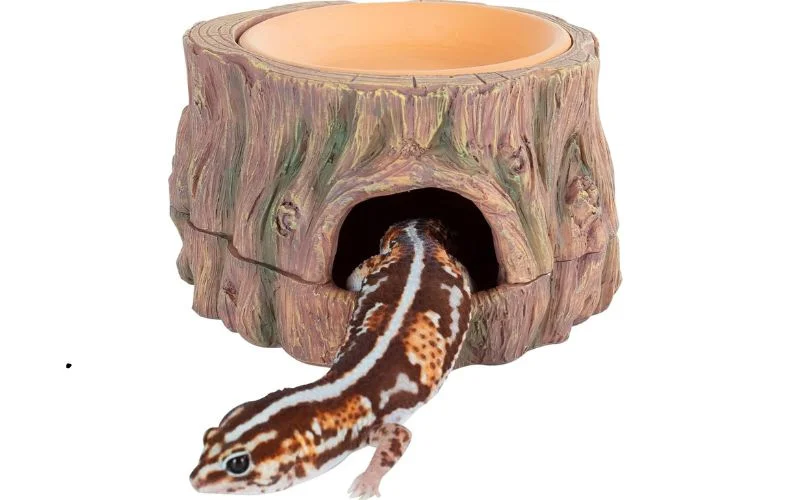

https://www.amazon.com/dp/B0C585B6Z2?tag=mus0a-21
Maintaining the right humidity levels is just as significant as temperature control for your corn snake’s health and well-being. Corn snakes require a humidity level between 40-60% in their enclosure for peak health and to guarantee smooth shedding. A hygrometer monitors the humidity levels regularly to achieve this. This helps prevent skin issues and respiratory problems from improper humidity.
During the shedding process, increasing the humidity to around 60-70% is essential. Higher humidity aids in loosening the old skin, making shedding easier for your snake. Providing a moist hide filled with damp sphagnum moss creates a humid microenvironment to which your snake can retreat when it needs extra moisture.
Maintaining proper humidity levels can lead to dehydration, making it difficult for your corn snake to shed its skin properly. Dehydration and poor shedding can lead to more severe health issues over time.
Suitable Substrate
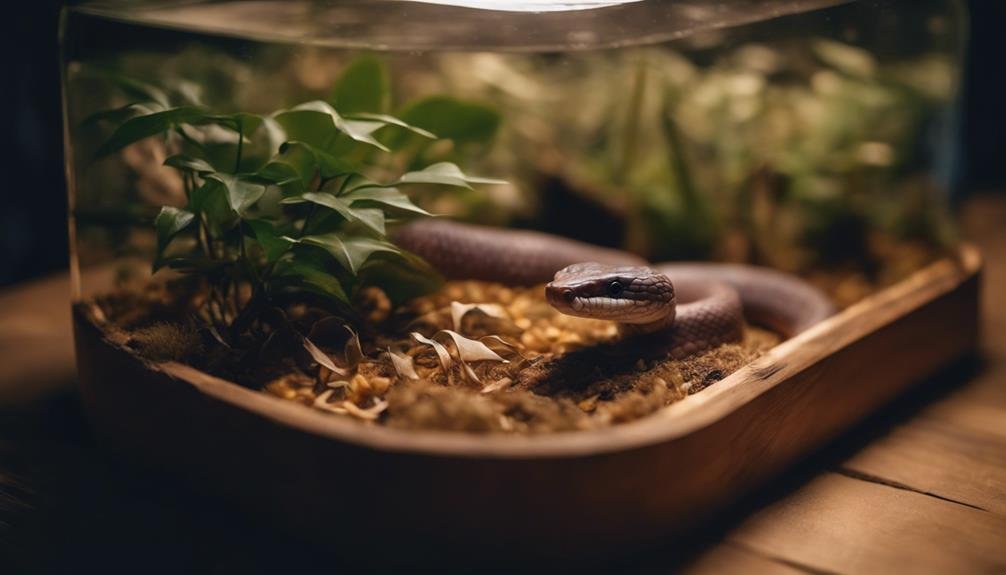

The appropriate substrate for your corn snake is crucial for its health and comfort. The right substrate can contribute to proper burrowing and shedding, essential behaviors for your snake’s well-being. Aspen shavings and paper towels are excellent choices because they’re safe and supportive of your snake’s needs.
Aspen shavings are particularly popular as they allow for burrowing and help maintain a secure environment. Paper towels are easy to change and ideal for a more hygienic setup. Avoid using cedar or pine substrates, as they can harm your snake’s respiratory system.
When setting up the substrate, consider the following:
- Depth: Make sure it’s deep enough for burrowing and regulating body temperature.
- Cleanliness: Regularly spot clean to remove waste and maintain a clean environment.
- Comfort: Choose a substrate that supports shedding and burrowing behaviors.
- Safety: Opt for substrates like aspen shavings or paper towels to prevent respiratory issues.
Enclosure Accessories
Why are enclosure accessories so important for your corn snake’s well-being? Accessories play a vital role in creating a habitat that mimics their natural environment, ensuring peak health and happiness.
Start by providing at least two hideout boxes. These are essential for your snake’s privacy and temperature regulation. Place one on the warm side and another on the cool side of the enclosure. This setup allows your corn snake to choose the most comfortable area based on its needs.
Add moist sphagnum moss to maintain proper humidity levels. This is especially important for promoting healthy shedding. Incorporate climbing branches and plants to provide mental stimulation and a more enriching environment. These elements make the enclosure more visually appealing and encourage natural behaviors.
Remember the basics: Always keep fresh water in a shallow dish. Clean and disinfect the enclosure weekly to ensure a hygienic living space and reduce the risk of disease.
Here’s a quick reference table to summarize key accessories:
| Accessory | Purpose | Benefits |
|---|---|---|
| Hideout Boxes | Privacy, Temperature regulation | Comfort, Stress Reduction |
| Climbing Branches | Mental stimulation | Natural behavior, Exercise |
| Fresh Water | Hydration | Health, Well-being |
Feeding Guidelines
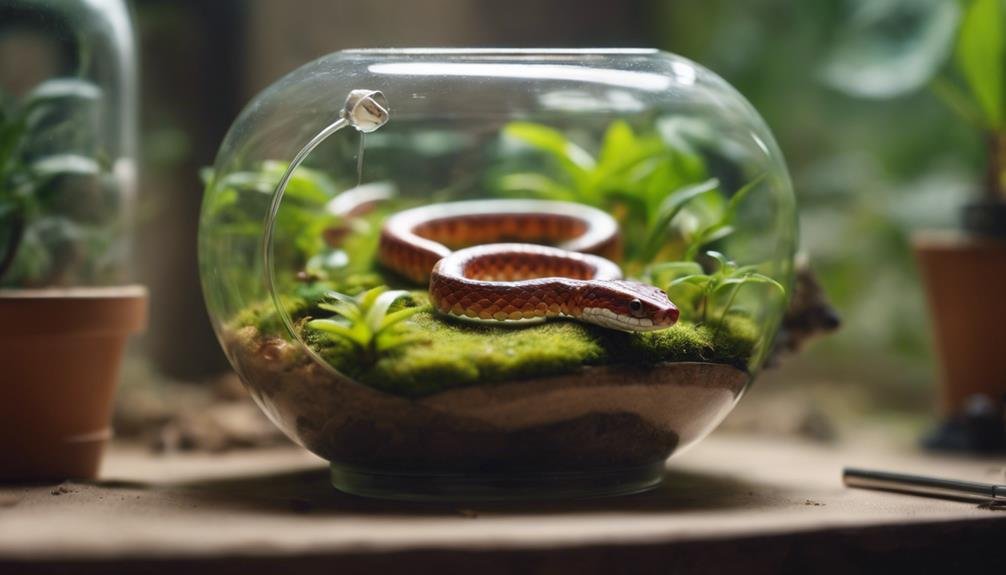

Feeding your corn snake properly is essential for its overall health and growth. In Corn Snake Care, following specific feeding guidelines is vital to ensure your pet thrives. Start by offering appropriately sized frozen thawed rodents, such as mice and rats. Hatchlings should be fed weekly, while adults need a meal every two weeks.
Key guidelines to follow include:
- Feed hatchlings weekly and adults every two weeks: Adjust the feeding frequency based on the snake’s age to meet its nutritional needs.
- Use appropriately sized prey: The rodent should be about the same width as the snake’s midsection to prevent choking or digestive issues.
- Monitor weight: Regularly check your snake’s weight to confirm it’s on a healthy growth trajectory.
- Avoid handling before feeding: Handling your snake can cause stress, leading to potential regurgitation.
Always provide water in a shallow dish to hydrate your snake. This is a critical aspect of Corn Snake Care, as dehydration can lead to severe health issues.
Health Monitoring
Regularly monitor your corn snake’s health by checking for signs of illness, such as wheezing, lethargy, or changes in appetite. Observing your snake’s behavior and activity levels is essential. A healthy corn snake should be active, alert, and responsive. If you notice your snake becoming unusually sluggish or hiding more than usual, these could be signs of health issues.
During handling sessions, inspect your corn snake for mites or ticks. If left untreated, these pests can cause significant health problems. Look for small, moving specks on your snake’s skin, particularly around the eyes and under the scales. Regular checks will help you catch any infestations early.
Shedding is another key aspect of your snake’s health. Monitor the condition of your corn snake’s skin and ensure the shedding process is complete and in one piece. Incomplete sheds can indicate underlying health problems or improper humidity levels.
Always be vigilant for red flags in your corn snake’s health. Prompt action can make a significant difference. If you notice any concerning symptoms, don’t hesitate to seek veterinary care to address potential issues early on. Your proactive approach will help keep your corn snake healthy and thriving.
Veterinary Care
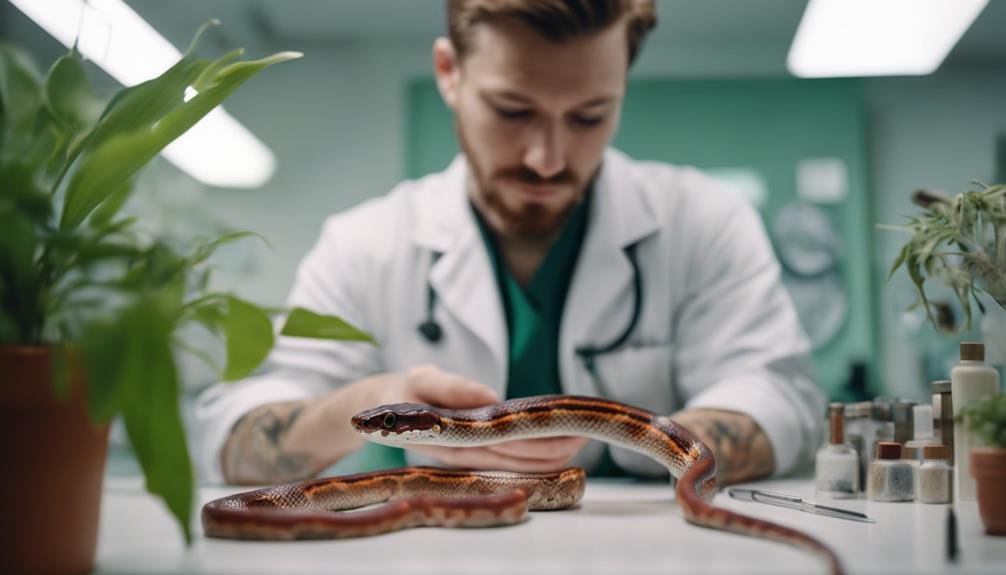

Ensuring your corn snake receives proper veterinary care is vital for its health and longevity. Regular veterinary care helps monitor health and catch any potential issues early.
You should be vigilant for signs of illness, such as wheezing, lethargy, or abnormal behavior. If you notice any of these signs, it’s important to consult a reptile-savvy veterinarian who’s experienced with corn snakes and their specific health concerns.
Regular veterinary care involves:
- Annual check-ups are key to preventing health issues and ensuring your corn snake’s well-being.
- Health monitoring: Routine visits help track your pet’s health status and growth.
- Preventive care: Early detection of issues can prevent serious health problems.
- Expert advice: A reptile-savvy veterinarian can provide tips on diet, habitat, and other aspects of corn snake care.
Conclusion
Caring for a corn snake isn’t just about setting up a habitat but creating a thriving environment. You’ll guarantee your snake’s well-being by managing temperature, lighting, and humidity and providing the right substrate and accessories.
Remember regular feeding, health checks, and veterinary visits. By paying attention to these details, you’ll keep your corn snake happy and healthy, making your pet-keeping experience rewarding and enjoyable.

